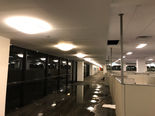
EMERGENCY SERVICES
When Sagebrush is called out for an emergency, a few simple detailed questions will be presented to the caller to identify the type of emergency. These questions will help the on-call Project Manager dispatch the appropriate personnel and equipment to the site. On-call personnel have the training and ability to handle all types of projects from small minor floods up to large scale catastrophic events. Before the removal of impacted building materials can be done, compliance with State/Local Air Quality and the Federal NESHAP 40 CFR 61 sub-part M must be adhered to.
Water
When an emergency call is placed, Sagebrush will dispatch a team of certified technicians and the Emergency Response Unit. Technicians are certified in Water Restoration (WRT) and Applied Structural Drying (ASD) techniques. Sagebrush uses only state of the art equipment and methodologies in the drying process.
Sagebrush uses the IICRC Standard and Reference Guidelines during the response to a water loss or water intrusion. While implementation of these standards is the best course of action, additional assistance from an industrial hygienist, certified building inspector, building engineer and/or owner representative will most likely be required.
Restoration Services
Having worked with most major insurance carriers, Sagebrush offers full service restoration to include electronics, documents, minor repairs and replacement or rebuilding of the damaged structure to a pre-loss condition.
Wind
Sagebrush has trained personnel to handle the random storms, seasonal monsoon and haboob activity that occurs in the Southwestern United States. From 100 mile an hour storm cells folding over 8” diameter fencing, 120’ tall x 8’ diameter Eucalyptus trees, to tearing metal roofs completely from their structure, we are here to assist.
Fire
Sagebrush uses the IICRC Standard and Reference Guidelines along with the latest technology in equipment, chemicals, processes and procedures to accomplish successful fire damage cleanup and deodorization. Water damage is a collateral effect, along with soot and smoke as a result of a fire. It is for these reasons that time related contamination has an impact and needs to be addressed quickly to mitigate exposures and minimize the loss.
Before any removal of fire debris can be done, compliance with State/Local Air Quality and the Federal NESHAP 40 CFR 61 Subpart M must be adhered to. In the event a thorough survey has not been performed at the facility, Sagebrush will assume all building materials are Asbestos Containing Materials (ACM) until proven otherwise.



















